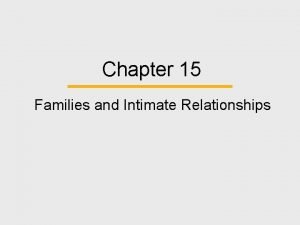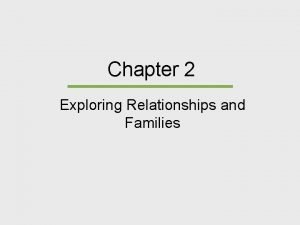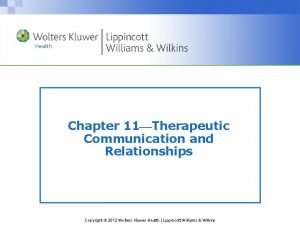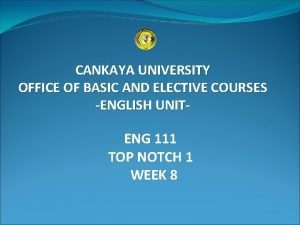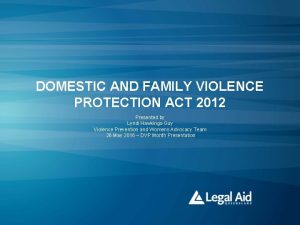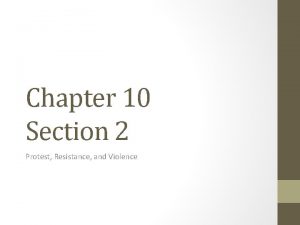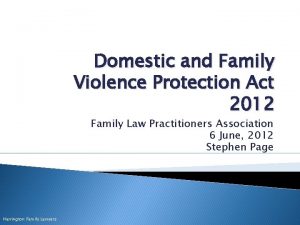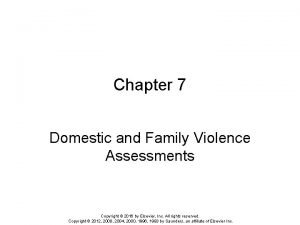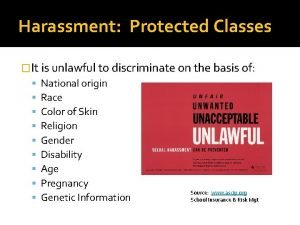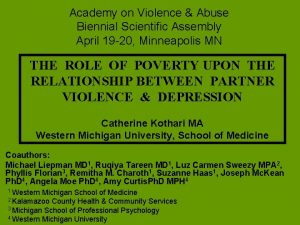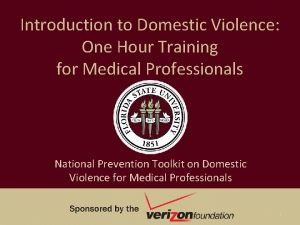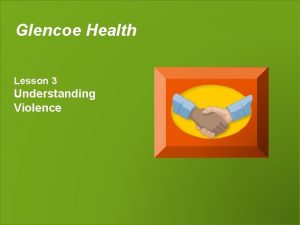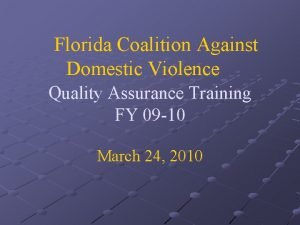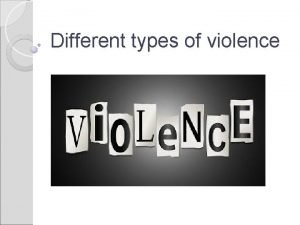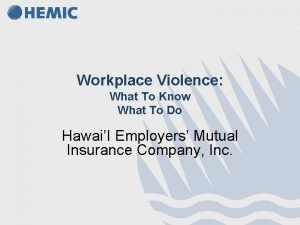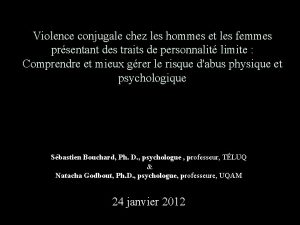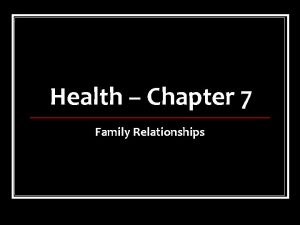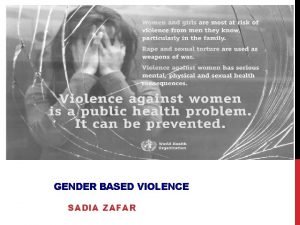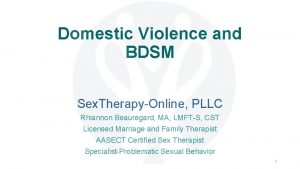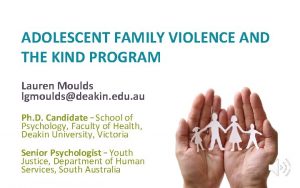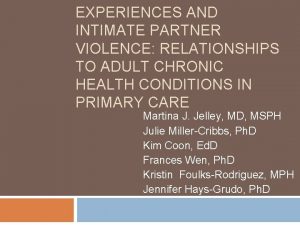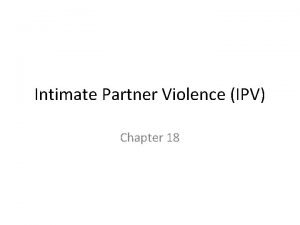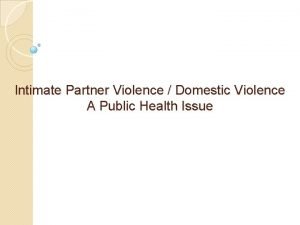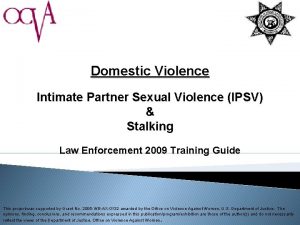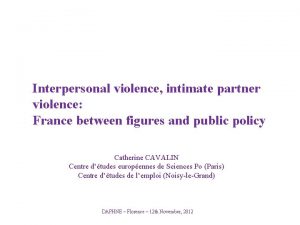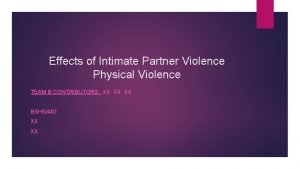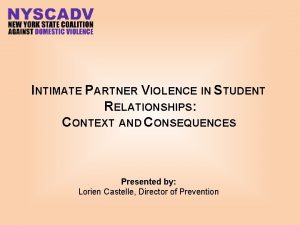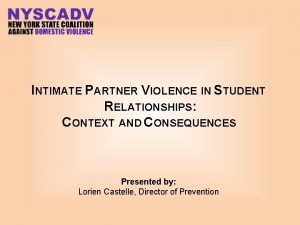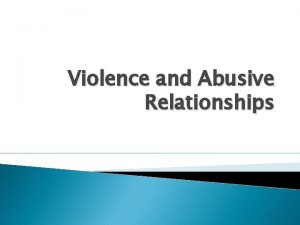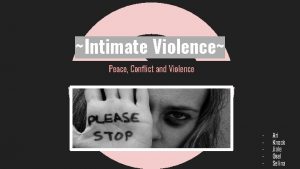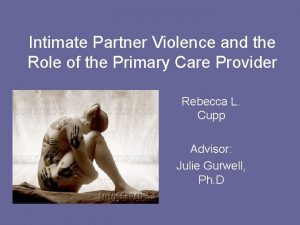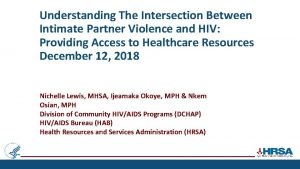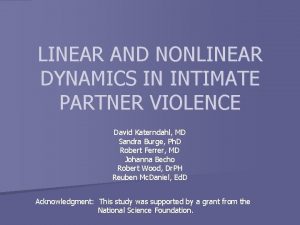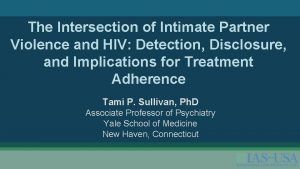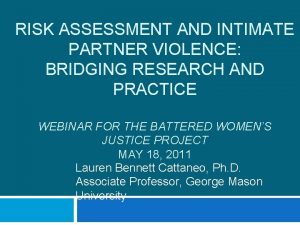EXPERIENCES AND INTIMATE PARTNER VIOLENCE RELATIONSHIPS TO ADULT













































- Slides: 45

EXPERIENCES AND INTIMATE PARTNER VIOLENCE: RELATIONSHIPS TO ADULT CHRONIC HEALTH CONDITIONS IN PRIMARY CARE Martina J. Jelley, MD, MSPH Julie Miller-Cribbs, Ph. D Kim Coon, Ed. D Frances Wen, Ph. D Kristin Foulks-Rodriguez, MPH Jennifer Hays-Grudo, Ph. D

OKLAHOMA

Community Engagement: Creating The Nation’s First School of Community Medicine

Education, income and health Population Ages 25 & Older, < than HS Degree, 2000 Percent of population >20 years with diabetes, 2007 Percent of population with age-adjusted Percent of Population Living in Poverty, 2004 CVD, 2000 www. cdc. gov/dhdsp/library/index. htm

COMMONWEALTH FUND State Scorecard Summary of Health System Performance

Access to and equity in healthcare key health determinants. Health status is variable across the Tulsa region. NORTH TULSA Shorter Life Expectancy 14 Year difference in Life Expectancy Across Tulsa County SOUTH TULSA Longer Life Expectancy

Social determinants of health are the conditions in which people are born, grow, live, work and age. WHO Commission on Social Determinants of Health, final report, 2008.

Just one of our clinic’s patient Female, age 34 Morbidly obese, BMI 60 Smoker Oxygen-dependent COPD Poorly controlled DM 2

Social history (taken directly from her chart) Married, 3 children ages 8, 13, 15. Molested at 8, raped at 13. Grew up in home with alcoholism, instability and physical abuse.

The rest of the story Last year this patient was found dead at home, age 36 Death thought to be due to MI or respiratory failure

University of Oklahoma-School of Community Medicine The Mission, Vision and Goal Mission: The mission of the University of Oklahoma is to provide the best possible educational experience for students through excellence in teaching, research, creative activity and service to the state and society. The University of Oklahoma School of Community Medicine (OUSCM) focuses this mission on explicitly improving the health and health care of the entire community. Vision: Educate and train a new generation of practitioners with the skills and desire to improve the health status of all Oklahomans. Build a learning community to improve the health of individuals and their communities through caring, learning, research, collaboration and dignity. Goal: Leverage the leadership, education, research and clinical service resources of OU-Tulsa to improve the health of entire communities

ACE Pathways – Health Example Increased mortality & morbidity Chronic disease and conditions Biological imbedding of traumatic experiences, heightened stress, allostatic overload Problematic behaviors Impaired social, cognitive, emotional functioning Impaired bio/neurological functioning Adverse Childhood Experiences

ACE Pathways – Health Example Increased mortality & morbidity Chronic Poor attachment, selfregulation, and lack of attention/focus ‘working memory’ disease and conditions Problematic behaviors Impaired social, cognitive, emotional functioning Impaired bio/neurological functioning Adverse Childhood Experiences

ACE Pathways – Health Example Poor diet, exercise, sedentary lifestyle, smoking, risky sexual behaviors Increased mortality & morbidity Chronic disease and conditions Problematic behaviors Impaired social, cognitive, emotional functioning Impaired bio/neurological functioning Adverse Childhood Experiences

ACE Pathways – Health Example Obesity, hypertension, HIV, mental health challenges Increased mortality & morbidity Chronic disease and conditions Problematic behaviors Impaired social, cognitive, emotional functioning Impaired bio/neurological functioning Adverse Childhood Experiences

ACE Pathways – Health Example Death & Impairment: heart attack, cancer, suicide Increased mortality & morbidity Chronic disease and conditions Problematic behaviors Impaired social, cognitive, emotional functioning Impaired bio/neurological functioning Adverse Childhood Experiences

ACE effects Individuals with high ACE scores are thus neurologically at risk to develop psychological and behavioral responses to stress that have short-term benefits but long-term negative consequences (e. g. , smoking, overeating, and alcohol abuse).

Primary care clinics Internal Medicine – at main Schusterman campus � Also has Ob-Gyn, Pediatrics, Psychiatry and Pediatric Endocrinology clinics at this site Family Medicine – stand alone clinic next to Hillcrest Hospital Bedlam Clinic – free clinic with evening visits staffed by volunteer physicians, students (medical, nursing, social work, pharmacy), faculty

Questionnaire Standardized 100 -item questionnaire assessed: � childhood adversity (ACEs), � current mental and physical health � material hardship � community context � social support Participant could choose to complete on their own with RA available for questions or be interviewer-administered

OU-SCM IM, FM, and Bedlam Clinic Patients 354 patients, age 18 -90, individually interviewed summer of 2012 Demographics: 75% female � 36% single, 26% married, 23% divorced/separated � Ethnicity � 60% white � 20% African American � 9% American Indian � 7% Hispanic � 3% Multi-ethnic � 0. 6% Asian

Demographics, cont. Mean age: 46 Education: � Less than high school: 24% � High school/GED: 45% � Vocation/tech/trade: 14% Food stamps: 57% yes Disability benefits: 43% yes Current health insurance: 76%

Risk factors Current smokers: 38% Ever smoked: 67% Exercise regularly: 47% � Mean 58 minutes per week Alcohol � Males who drink: 20% more than 4/day � Females who drink: 20% more than 3/day Obesity (BMI > 30): 27%

EMR review Each participant gave permission for review of their medical record Problem lists for each participant were printed at the time of their questionnaire A coding list of chronic health conditions (including mental health) was created The problem list was used to determine the number and specific chronic health conditions for each participant

Chronic health conditions Hypertension Diabetes � � Prediabetes � � CAD CHF PAD CVD/stroke Obesity Hyperlipidemia COPD Asthma Chronic kidney disease Arthritis Chronic pain Back, fibromyalgia, neuropathy, other Chronic headache Mental health conditions � Cardiovascular disease � � � � Depression Anxiety PTSD Panic disorder Bipolar Schizophrenia Borderline personality disorder HIV Hepatitis C Risky behaviors � � Tobacco use Substance abuse Alcohol Other

Self-reported health and mental health Questionnaire included SF-8 questions, last 4 weeks � Overall health rating � Limitations, pain, energy, emotional problems Depression screen � Past week � Past year � Lifetime

ACE and IPV screening Basic 10 ACE questions � Score given 0 -10 Universal Violence Prevention Screening Protocol � Current – within the past year Slapped, kicked, pushed, choked, punched Forced sex Threatened with weapon Threatened with bodily harm Verbal abuse causing fear Threats, put downs, rejections � Ever – same 6 questions

OU-SCM Patients: ACEs Verbal abuse 41. 6% Physical abuse 31. 9% Sexual abuse 26. 6% Unloved 33. 8% Needs unmet 19. 6% Witness IPV 24. 7% Sep/Divorce 40. 9% Alcohol/drugs 36. 8% Mental illness 26. 8% Prison 17. 5% ACE score 30. 1% 35. 7% 0 or 1 2 to 4 5+ 34. 2%

Bivariate Analysis IPV ever highly correlated with all ACEs, except having family member in prison � Most highly correlated with sexual abuse (Pearson correlation. 418), verbal abuse (. 358), alcohol and drugs in the home (. 330), emotional abuse (. 325), witnessing IPV (. 312) and physical abuse (. 302) Those who have experienced IPV ever have more pain, more health conditions, more mental health conditions, PTSD and depression IPV current predicts only PTSD, not pain, health conditions, mental health or depression

OU-SCM patients: ACEs and health Chronic conditions (z-scores) by ACE score 1 0. 8 Heart Disease Risk X Mental Health Condition 0. 6 Health 0. 4 0. 2 Mental Health 0 Mental Health/Substance Abuse -0. 2 -0. 4 Pain -0. 6 0 1 2 3 4 5 6 ACE score 7 8 9 10

Depression and PTSD by ACE score 2 Depression & PTSD (z-scores) by ACE score 1. 5 Depressi on 1 0. 5 PTSD 0 -0. 5 -1 0 1 2 3 4 5 ACE score 6 7 8 9 10

ACEs and IPV – Health Effects Multiple studies have shown long-term health effects of both ACEs (Felitti and Anda 1998) and IPV (Campbell 2002, Coker 2000 and 2002) Primary care screening has focused on IPV, current or lifetime Screening for IPV has become fairly standard but asking about ACEs in adults is not routine (Wienreb et al 2010) Recent USPSTF recommendation for IPV screening

Hypothesis Apparent correlation of IPV with chronic health conditions is due, in part, to high ACE score in IPV victims We expect to see that IPV becomes a weaker predictor when ACEs are in the model

IPV ever, current and PTSD by ACE score 2 1. 5 IPV Ever Z-scores 1 IPV Current 0. 5 PTSD 0 0 1 2 3 4 5 6 -0. 5 -1 ACE score 7 8 9 10

Statistical analysis Data was analyzed using SPSS Bivariate analyses done to determine correlations and form the subsequent regression models Demographic variables correlating with health status used in models IPV ever, IPV current and ACE sum score added to models with dependent variables of total health conditions, self-reported health, mental health conditions, cardiovascular risk, chronic pain and PTSD

Regression model results DV: Health conditions from EMR � Associated with age, education, and ACE score (B =. 193, p=0. 001) � IPV not associated (B=. 090, p=0. 171) DV: Self-reported health (SF-8) � Associated with age, health literacy, community problems, material problems, ACE score (B=. 474, p=0. 001), IPV ever (B=. 344, p=0. 037)

Regression results, cont. DV: Mental health conditions (from EMR) � Associated with ethnicity (white, more conditions) and ACE score (B=. 043, p=. 04) � IPV not associated (B=. 020, p=0. 42) DV: Cardiovascular risk (combination of several diagnoses) � Associated only with age � ACE and IPV not significant but trend apparent with ACE (B=. 059, p=. 052) but not IPV (B=. 008, p=. 835)

Regression results, cont. DV: Chronic pain � Associated with age, education, food stamps � ACE and IPV not associated but both with trends (ACE p=. 083, IPV p=. 088) � Interestingly, IPV was significant but significance gone when ACE added DV: PTSD (screened with interview) � Associated with ACE (B=. 211, p=. 000), IPV ever (B=. 146, p=. 000)and IPV current (B=. 215, p=. 001)

Limitations Relatively small sample in one community Had to rely on chronic conditions listed in EMR, may have missed some diagnoses Brief IPV screening as part of larger survey

Conclusions Some of the health effects found to be correlated with IPV may be due, in part, to ACEs IPV and ACE are strongly correlated Consideration for re-analysis of previous larger data sets to confirm this finding Primary care screening for violence and abuse should include an ACE score

Future questions Is IPV just one of the many detrimental outcomes of ACEs? In a population of persons with ACE score of 0, how common is IPV and if it occurs, what are the health effects? What should the primary care clinician do when high ACE score discovered?

Mindful Changes: Improving chronic conditions related to childhood adversity A behavioral intervention that first addresses capacity to self-regulate, control thoughts and impulses and form social attachments prior to implementing traditional modalities of behavior change will be more effective than interventions that assume these skills have been developed and are already in place.

Mindfulness-Based Stress Reduction (MBSR) MBSR helps participants to develop a mindful cognitive state and incorporate it into everyday life as a coping resource to deal with Increase intense physical, emotional, and situational stressors. d � Preventive - increasing healthy coping strategies � Stressors can be managed before social, cognitive, and emotional functioning impact mortality & morbidity Chronic disease and conditions Problematic behaviors Avoidance of Impaired Social, Cognitive, Emotional functioning Impaired social, cognitive, emotional functioning Impaired bio/neurological functioning Adverse Childhood Experiences

“THIS WORK WAS SUPPORTED, IN PART, BY A GRANT FROM DHHS, HEALTH RESOURCES AND SERVICES ADMINISTRATION (HRSA), BUREAU OF HEALTH PROFESSIONS ACADEMIC ADMINISTRATIVE UNITS AWARD NOS. D 54 HP 05259 AND D 5 AHP 19901; AND THE UNIVERSITY OF OKLAHOMA-TULSA ANNE AND HENRY ZARROW SCHOOL OF SOCIAL WORK. ”

Questions?

ACE Research The research literature has firmly established that Adverse Childhood Experiences (ACEs) are significantly associated with physical and mental health outcomes, and health behaviors. Direct Effect on psychological and physical health through the biological embedding of the stress response in the nervous, endocrine and metabolic systems. Indirect Effect through impaired neurological functioning specifically the structural and functional areas of the brain responsible for 1) forming secure attachments 2) regulating negative thoughts and feelings 3) focusing attention. Impairments in these executive function skills negatively impact the quality of interpersonal relationships, working memory, and behavioral responses to stress.
 The spyware used in intimate partner violence
The spyware used in intimate partner violence Define the relationship chapter 15
Define the relationship chapter 15 Love and communication in intimate relationships
Love and communication in intimate relationships Sternberg love types
Sternberg love types The impact of incarceration on intimate relationships
The impact of incarceration on intimate relationships Intimate distance is
Intimate distance is Intimate family chapter 6
Intimate family chapter 6 Intimate family chapter 6
Intimate family chapter 6 Meaning of initmacy
Meaning of initmacy Intimate family chapter 2
Intimate family chapter 2 Consultative register
Consultative register Dewgarden foaming intimate wash benefits
Dewgarden foaming intimate wash benefits Zones of space communication
Zones of space communication Intimate zone in communication
Intimate zone in communication Cankaya university
Cankaya university Me line 02 intimate
Me line 02 intimate Abcde of intimate relationship
Abcde of intimate relationship The modifiers of human act
The modifiers of human act Domestic and family violence protection act 2012
Domestic and family violence protection act 2012 Gandhi king and mandela what made non-violence work dbq
Gandhi king and mandela what made non-violence work dbq Chapter 9 lesson 2 resolving conflicts
Chapter 9 lesson 2 resolving conflicts Chapter 27 anger aggression and violence
Chapter 27 anger aggression and violence Chapter 10 section 2 protest resistance and violence
Chapter 10 section 2 protest resistance and violence Domestic and family violence protection act 2012
Domestic and family violence protection act 2012 Chapter 9 resolving conflicts and preventing violence
Chapter 9 resolving conflicts and preventing violence Chapter 10 section 2 protest resistance and violence
Chapter 10 section 2 protest resistance and violence Framework agreement on harassment and violence at work
Framework agreement on harassment and violence at work Routine, universal screening for domestic violence means
Routine, universal screening for domestic violence means Workplace violence and harassment quiz answers
Workplace violence and harassment quiz answers Seceding states of the confederacy
Seceding states of the confederacy Academy on violence and abuse
Academy on violence and abuse Indicators of potential workplace violence
Indicators of potential workplace violence Violent one hour
Violent one hour Thesis statement gun control
Thesis statement gun control Chapter 9 lesson 3 understanding violence
Chapter 9 lesson 3 understanding violence Florida coalition against domestic violence
Florida coalition against domestic violence Different types of violence
Different types of violence Expressive violence
Expressive violence Indicators of potential workplace violence
Indicators of potential workplace violence Borderline violence conjugale
Borderline violence conjugale Johan galtung triangle
Johan galtung triangle Three r's for stopping domestic violence
Three r's for stopping domestic violence Pyramid of gender based violence
Pyramid of gender based violence Fvip georgia
Fvip georgia Domestic violence kink
Domestic violence kink Adolescent family violence program
Adolescent family violence program

